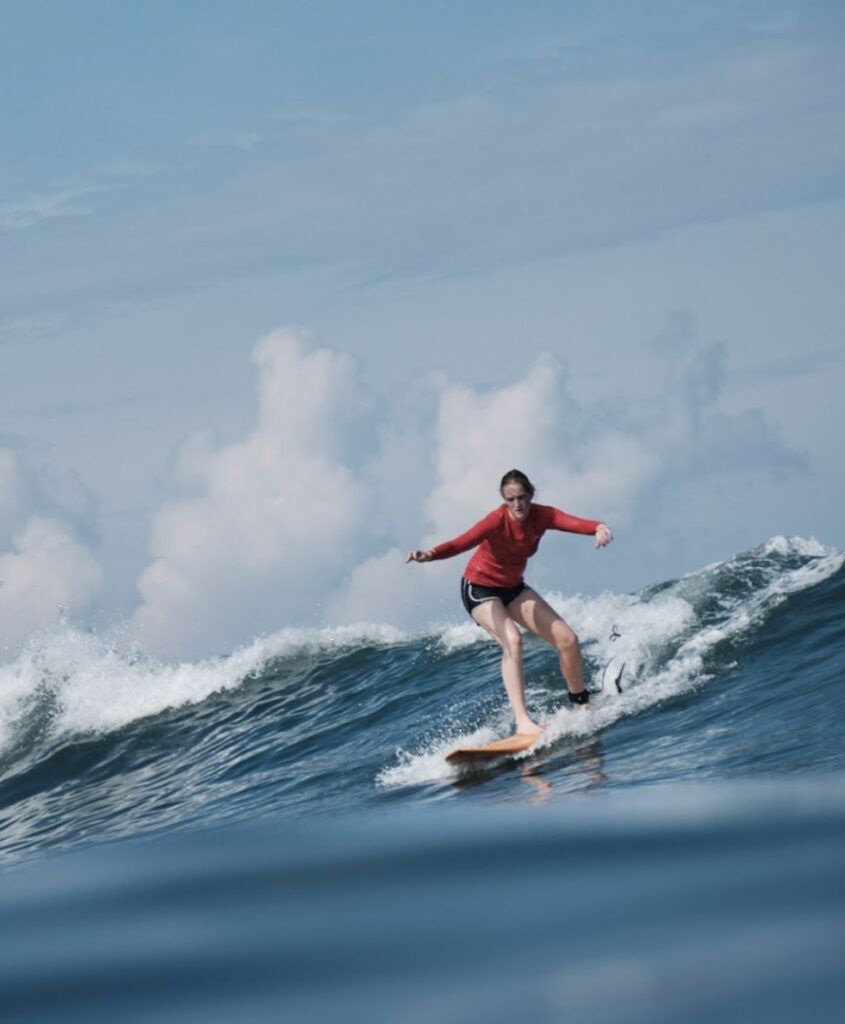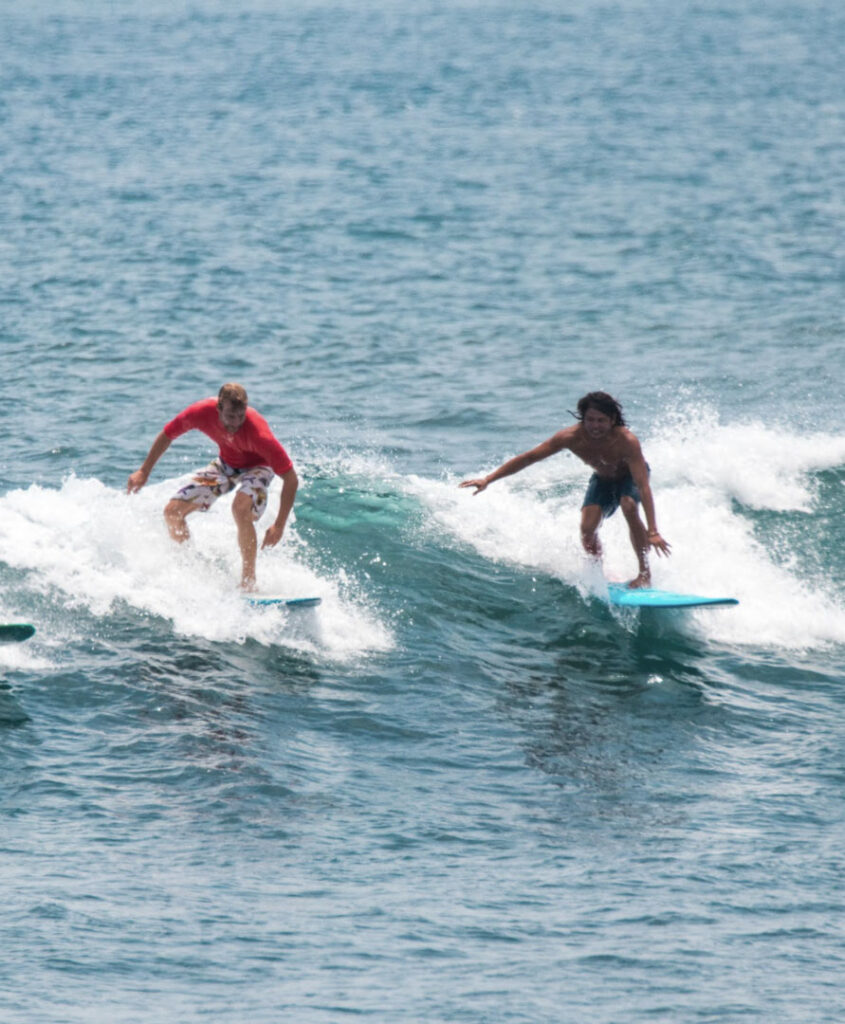LEARN TO SURF
SOLID SURF & YOGA HOUSE
Learn to Surf : A Beginner’s Guide to
Catching Your First Waves
What is Surfing and Why Should You Learn?
Surfing is a sport that has been around for centuries, and it continues to be a favorite pastime for many people around the world. The thrill of catching a wave and riding it to shore is unmatched by any other experience. If you’re new to surfing, it can seem daunting at first, but with the right mindset and a few key techniques, anyone can learn to surf.
There are many reasons why you should consider learning to surf. For one, it’s a great way to stay in shape. Surfing requires a lot of physical exertion, from paddling out to the waves to standing up and riding them. It’s a full-body workout that can help you build strength, endurance, and balance.
In addition to the physical benefits, surfing can also be a great way to de-stress and connect with nature. There’s something meditative about being out on the water, feeling the sun on your skin, and listening to the sound of the waves. It’s a great way to clear your mind and get away from the stresses of daily life.

What Equipment Do You Need to Learn to Surf?
Before you hit the waves, you’ll need to make sure you have the right equipment. The most important piece of gear is, of course, the surfboard. As a beginner, you’ll want to start with a board that is large and stable, as this will make it easier to catch waves and maintain your balance.
You’ll also need a wetsuit, especially if you’re surfing in colder water. A good wetsuit will keep you warm and comfortable, allowing you to stay in the water for longer periods of time.
Other essential gear includes a leash, which attaches your board to your ankle and prevents it from floating away, and wax, which helps to create traction on your board.
Where Can You Learn to Surf?
There are many places around the world where you can learn to surf, but some are better than others for beginners. Look for a surf school or camp that specializes in teaching beginners, as they will have the right equipment and experienced instructors to help you get started.
If you’re in the United States, some of the best places to learn to surf include California, Hawaii, and Florida. In Europe, Portugal, France, and Spain are popular destinations for surfers of all skill levels.

What Are Some Basic Surfing Techniques to Learn?
As a beginner, there are a few key surfing techniques that you’ll want to focus on. These include:
This is the act of using your arms to propel yourself forward on the board. Good paddling technique is essential for catching waves and staying in position.
This is the process of getting from a lying position on the board to a standing position. It requires good upper body strength and balance.
Once you’re standing on the board, you’ll need to find a comfortable and stable stance. This will involve bending your knees slightly and positioning your feet in the right spot on the board.
As you progress, you’ll want to learn how to turn the board. This can be done by shifting your weight and using your arms to guide the board in the desired direction.
How Can You Stay Safe While Surfing?
Surfing can be a fun and exhilarating sport, but it’s important to take safety seriously. Some key safety tips to keep in mind include:
Always surf with a partner: Having someone with you can make all the difference in case of an emergency.
- Be patient: Learning to surf takes time and practice. Don’t get discouraged if you don’t see progress right away.
- Stay positive: A positive attitude can make all the difference in your surfing journey. Remember to have fun and enjoy the experience.
- Stay safe: Always be aware of your surroundings and any potential hazards in the water.
- Get the right gear: Make sure you have the proper equipment, including a board that is the right size for you and a wetsuit if needed.
- Find a good teacher: A qualified surf instructor can help you progress faster and avoid common mistakes.
- Practice good technique: Good technique is essential for improving your surfing skills and avoiding injuries.
- Watch and learn: Observe other surfers and learn from their techniques and mistakes.
- Have fun: Remember that surfing is ultimately about having fun and enjoying the experience. Don’t take it too seriously and enjoy the ride!
Conclusion
learning to surf can be a rewarding and exhilarating experience, but it also requires patience, dedication, and a willingness to learn from your mistakes. By following the tips and guidelines outlined in this article, you can minimize your risks, maximize your progress, and enjoy the many benefits that come with riding the waves. Remember to always prioritize safety, stay within your limits, and have fun! With time and practice, you too can become a confident and skilled surfer, ready to take on any challenge that comes your way. So what are you waiting for? Grab your board, hit the beach, and start your journey towards becoming a surfing pro today!
Frequently Asked Questions (FAQ)
About Learn to Surf
Surfing can be challenging for beginners, but with proper instruction and practice, it can be learned by anyone.
It varies depending on factors such as natural ability, physical fitness, and frequency of practice, but most people can learn the basics in a few lessons.
While swimming skills are important for safety reasons, you don’t need to be an expert swimmer to learn to surf. Beginner lessons usually take place in shallow water where you can stand up.
Wear a comfortable swimsuit or wetsuit, a rash guard or t-shirt to protect your skin from the sun and the wax on the board, and surf booties if the water is cold.
Most surf schools provide all the necessary equipment, including surfboards, wetsuits, and leashes.
In your first lesson, you will learn the basics of paddling, standing up, and riding waves. Your instructor will also teach you about ocean safety and etiquette.
Yes, many surf schools offer lessons for children as young as six years old. However, it’s important to choose a reputable surf school with experienced instructors and appropriate safety measures.
Answer: The best time to learn to surf depends on the location. In general, summer months have smaller waves, which are more suitable for beginners.
Surfing does involve some risks, but with proper instruction, equipment, and caution, it can be a safe and enjoyable activity.
While it’s possible to learn to surf on your own, it’s not recommended for beginners. A surf school can provide valuable instruction, equipment, and safety measures to ensure a successful learning experience.



